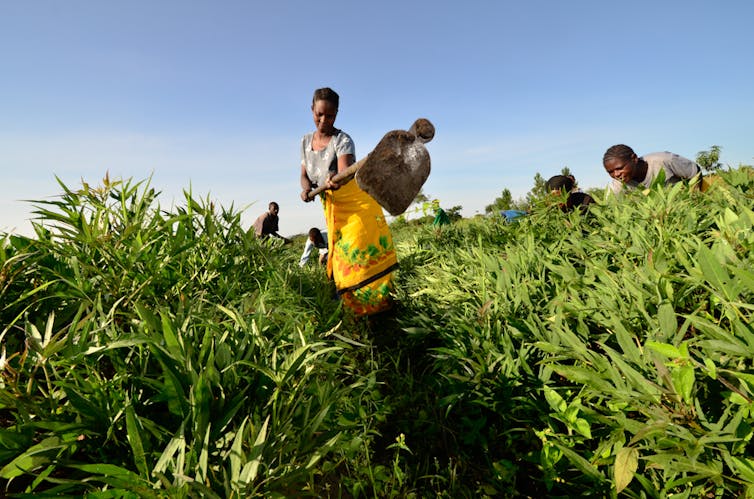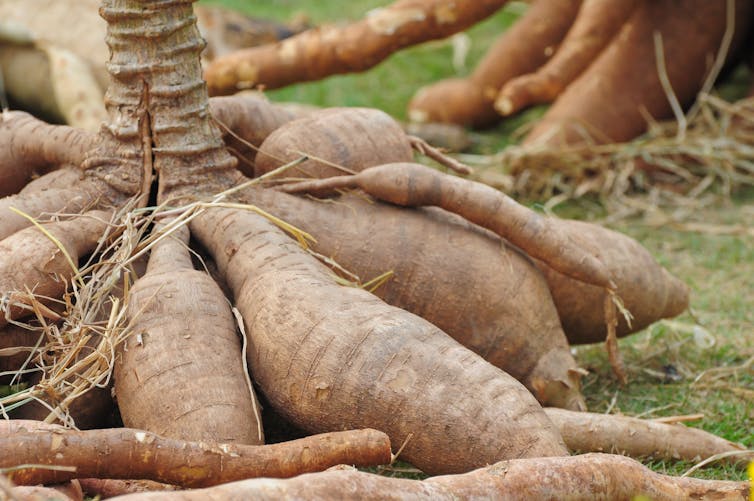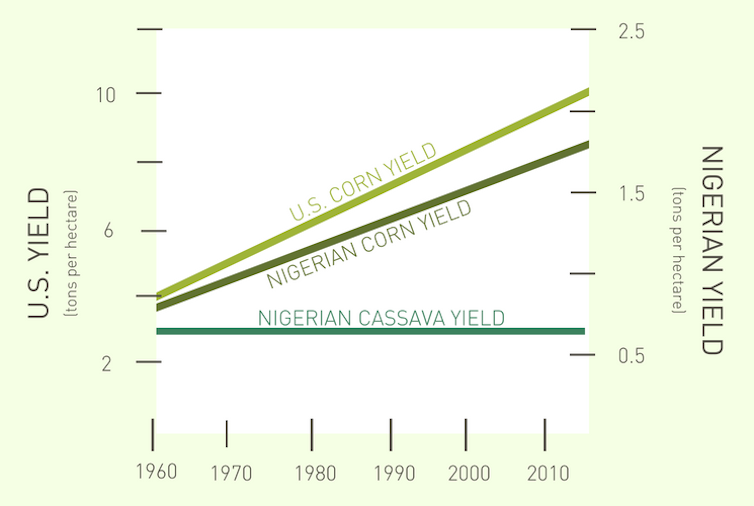Research shows how to grow more cassava, one of the world’s key food crops

Cassava makes up nearly 50 percent of the diet in parts of sub-Saharan Africa, where populations are projected to increase by more than 120 percent in the next 30 years. CIAT International Center for Tropical Agriculture, CC BY-NC-SA
What root vegetable is toxic eaten raw but a hunger quencher when cooked, and provides both tapioca flour and the pearls in bubble tea? This question probably will stump many Americans, but is easy for people in the developing world.
The answer is cassava, a woody shrub also known as manioc, yuca, tapioca, and mandioca. Originally from Brazil, cassava is the third most important source of calories in the tropics, behind rice and corn, and sustains an estimated 800 million throughout Africa, Asia, and Latin America. In sub-Saharan Africa, it provides 30 to 50 percent of all calories consumed.
Cassava is one of the most efficient producers of carbohydrates and energy among all food crops. It can produce more than 250,000 calories per hectare per day, compared to 176,000 for rice, 110,000 for wheat and 200,000 for corn.
But despite its widespread consumption, cassava yields have not improved in a quarter of a century. In a recently published study, our research group identified 14 paths for improving cassava yield potential through genetic modifications, both engineered and bred. Each route could increase yield by as much as 25 to 100 percent, while also improving how efficiently the plant uses precious resources such as water and fertilizer.
Many of these routes are believed to be “synergistic improvements” – opportunities to increase cassava yield that, when combined, increase the yield of the plant even more. In particular, we know that cassava is photosynthesizing far below its theoretical limit. If we can improve photosynthesis, we might gain substantial, sustainable increases in the yield of this important crop.

Versatile and hardy
Cassava’s edible roots grow in clusters of four to eight, each roughly the size of a bowling pin. These tubers are often steamed, fried or roasted, much like potatoes, but can also be ground up into flour or a starchy meal that is used as a condiment or side dish. The leaves can be cooked like spinach. Cassava is mainly grown for human consumption but is also used for animal feed, biofuel production and other products such as fabric starch and paper.
All parts of the cassava plant naturally contain cyanide, a poisonous compound. Toxic, or “bitter,” cultivars contain as much as 50 times more cyanide as less toxic “sweet” varieties. Peeling and then cooking cassava neutralizes the cyanide in most sweet cultivars, while bitter cultivars need to soak or ferment for at least eight hours to make the plant edible.
Cassava thrives in poor soil with little water, so it is an ideal crop to grow on marginal land in sub-Saharan Africa and other developing regions. Farmers can harvest parts of the perennial plant as needed for food or sell as a cash crop.
Stagnant yields
According to our review, cassava yields per acre in Nigeria – the major producer in Africa – have flatlined since 1961. By contrast, corn yields in Nigeria, as in the United States, have more than doubled over the same period.

Credit: The RIPE project
One solution would be to introduce alternative crops with higher yields. But respecting people’s food preferences is a key tenet of food security. And although cassava is not native to Africa, it has become an integral part of many people’s diets. It is also resilient to tough environments, and so is well-adapted to deal with climate change – particularly in sub-Saharan Africa, where heat and drought stress events are forecast to increase.
Most published research on cassava to date has focused on improving its nutritional value or disease resistance. But even with these improvements, its current yield potential creates a ceiling that limits how much food farmers can produce. Yield potential is the yield that a given cultivar or genetic form of a crop will achieve under ideal growth conditions and in the absence of pests and diseases. Although crops rarely grow under such conditions, increasing yield potential generally results in increased yields under most conditions.
Hacking photosynthesis to increase cassava yields
Hacking photosynthesis has long been considered to be a holy grail of plant biology. Photosynthesis is the process in which green plants use the energy of sunlight to synthesize food from carbon dioxide and water, fueling their growth. It is directly or indirectly the source of all of our food, as well as many of our fibers and most of our fuel. By simulating the process on supercomputers, we identified points where we might intervene to speed up the process.
Our research demonstrates that this theory can now be translated into real productivity increases in crops and that the potential payoff is significant. By genetically modifying tobacco plants, we increased the amount of plant tissue that they produced by 14 to 20 percent in real-world, replicated field trials where light, rainfall, and other factors are unpredictable. We used tobacco because it is easily modified, but also produces many layers of leaves, making it a good proxy for other crops. The process we modified is common to all plants, which strongly suggests that this approach should work just as effectively in cassava and other food crops.

Here’s how our approach works: In full sun, plants receive more energy than they can use. If they can’t get rid of this excess energy, it will bleach their leaves. To protect themselves, plants induce a process called photoprotection, which converts this excess energy harmlessly to heat.
But when a cloud passes overhead, it can take minutes to hours for the plant to fully recover and begin photosynthesizing at maximum capacity again. In the shade, lack of light limits photosynthesis and photoprotection causes the plant to waste precious light energy as heat.
Using a supercomputer, we predicted exactly how much slow recovery from photoprotection reduces crop productivity over the course of a day. Our calculations revealed a 7.5 percent to 40 percent yield hit, depending on the type of plant and prevailing temperature.
Teaming up with key collaborators at the University of California, Berkeley, we developed a “cassette” of genes to speed up plant recovery from photoprotection by boosting the amount of three proteins involved in photosynthesis. Two of our modified plant lines consistently achieved 20 percent higher productivity than unaltered tobacco plants, while the third was 14 percent higher.

Engineering the future today
Now we are using this same cassette of genes to improve how quickly cassava recovers from photoprotection. Other “synergistic improvements” on our radar include steps such as engineering plants to produce fewer leaves; improving the way leaves are arranged to better capture light, and altering leaf color to reduce shading of lower leaves. We are also working to reduce losses from photorespiration, a parasitic process that occurs during photosynthesis when oxygen is accidentally used instead of carbon dioxide. Photorespiration causes plants to burn as much as 40 percent of the energy they have produced through photosynthesis. This problem will increase along with rising temperatures from climate change.
![]() It typically takes 15 to 20 years to move advances like these from the lab to farmers’ fields at scale. Because of that lag, in a world with a fast-growing population, we are just one crop breeding cycle away from starvation. It is therefore essential to start improving yields of staple crops like cassava now so that we will have these solutions when we need them.
It typically takes 15 to 20 years to move advances like these from the lab to farmers’ fields at scale. Because of that lag, in a world with a fast-growing population, we are just one crop breeding cycle away from starvation. It is therefore essential to start improving yields of staple crops like cassava now so that we will have these solutions when we need them.
By: Stephen P. Long | Amanda P. De Souza | Lynnicia Massenburg || The Conversation
